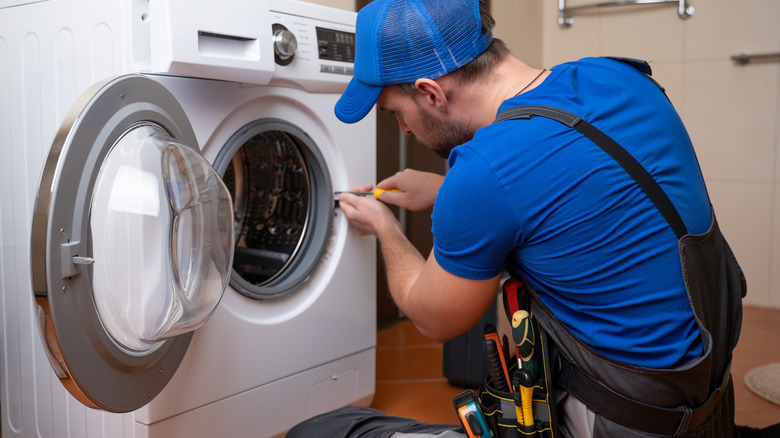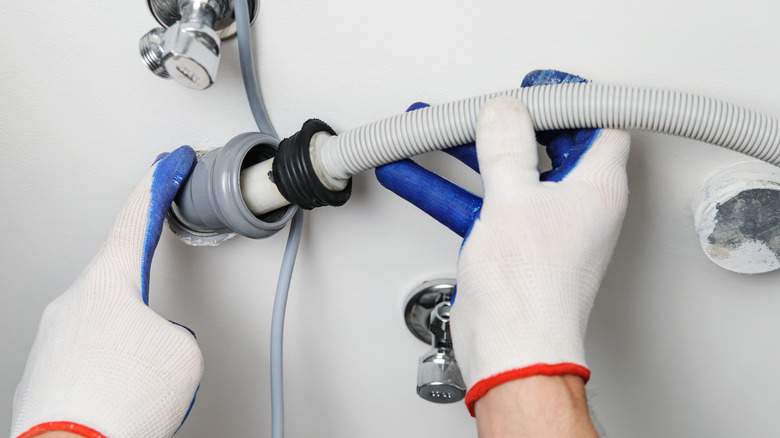The Big Mistake You're Making With Your New Washer And Dryer
The allure of shiny new gadgets often lies in their promises of innovation, efficiency, and seamless performance. When it comes to household appliances, especially something as indispensable as a washer and dryer, you eagerly anticipate the effortless laundry sessions that lie ahead. Yet, in your excitement, it's easy to overlook the basics. While today's machines are packed with features and advanced settings, some age-old truths never change. The foundation of your laundry experience starts long before you press that first button. Proper installation and maintenance are the unsung heroes behind every efficient laundry cycle. By neglecting these foundational steps, you're inadvertently setting yourself up for a cascade of problems. Beyond the technicalities, these lapses could cause leakages and compromise the longevity of your washer dryer, and even your safety.
Sleek designs and cutting-edge technology frequently lull homeowners into a false sense of security. But beneath that polished exterior, the heart of these machines beats similarly to their predecessors. While the surface may seem efficient and vibrant, a lack of proper care will reveal a number of issues waiting to surface. Hence, take the time, invest in understanding their requirements, and ensure they're given attention from the get-go. The rewards? Efficient cycles, a longer appliance lifespan, and clothes that look and feel their best.
The importance of proper washer and dryer installation
One can't stress enough how vital proper installation is for all laundry machines. It's not just about plugging them in and pushing them into the right spot against the wall. It's about ensuring they work optimally, safely, and efficiently. For instance, they must be sitting level. This might sound elementary, but achieving this can be a sophisticated task, depending on your floor's intricacies. Imagine a washing machine that's slightly tilted. It can cause the machine to operate inefficiently and lead to excessive vibrations, wear and tear on its components, or even water leaks.
However, ensuring your machine is level doesn't mean eyeballing it or trusting your floor's integrity. Using a leveling tool is a must. Depending on your floor's peculiarities — be it an unexpected dip, slant, or unevenness — you might need to make adjustments. This could involve adjusting the machine's legs or using leveling platforms. That being said, bear in mind that to set up your washer, you might have to first loosen the lock nuts on the front legs and adjust them, aiming to lower the machine for stability.
If you've done this installation independently, kudos to your DIY spirit. But consider this: Is it worth taking risks with such expensive equipment and your daily clothes? There's a line between self-reliance and ensuring optimal performance. Even the most skilled DIY enthusiasts can benefit from a second pair of eyes. Sometimes, getting a professional to double-check your work ensures you get your machines' maximum lifespan and efficiency.
Venting: An overlooked but critical aspect
Having established that your machines are level, it's time to delve deeper into an aspect many tend to disregard: the significance of proper venting. Venting is not just a rudimentary installation task, especially for your dryer. It's a pivotal component that directly influences your appliance's efficiency and safety. The intricacies lie in the details. For starters, the venting tube's size and material are paramount. A poor choice can lead to air leaks, potentially causing a disturbance in the ambient environment. Even more concerning, there's a risk of air bubbles being redirected to nearby toilets and sinks. The domino effect doesn't end there. An improper venting setup can also lead to an unexpected buildup of pressure in the plumbing system, which might result in flooding in worst-case scenarios.
The strategic positioning of the venting tube cannot be emphasized enough; it's about maximizing efficiency and safety. The design should primarily focus on promoting seamless airflow. When plotting the path for your venting tube, think of it as charting a direct course on a map that avoids unnecessary deviations and side routes. Imagine a pathway that's direct and devoid of unnecessary detours. Every added bend or turn isn't just a deviation; it's a potential hindrance to your dryer's optimal functionality. Such impediments can significantly reduce airflow, pushing your dryer to work harder, and increasing its susceptibility to wear and tear, which might present new hazards and lead to expensive washing machine repairs.


